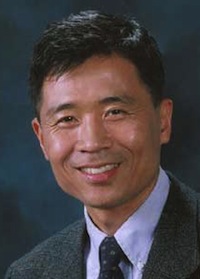Man-made material pushes the bounds of superconductivity
A multi-university team of researchers has artificially engineered a unique multilayer material that could lead to breakthroughs in both superconductivity research and in real-world applications.

Eom
The researchers can tailor the material, which seamlessly alternates between metal and oxide layers, to achieve extraordinary superconducting properties — in particular, the ability to transport much more electrical current than non-engineered materials.
The team includes experts from the University of Wisconsin–Madison, Florida State University and the University of Michigan. Led by Chang-Beom Eom, the Harvey D. Spangler Distinguished Professor of materials science and engineering and physics at UW–Madison, the group described its breakthrough March 3, 2013, in the advance online edition of the journal Nature Materials.
Superconductors, which presently operate only under extremely cold conditions, transport energy very efficiently. With the ability to transport large electrical currents and produce high magnetic fields, they power such existing technologies as magnetic resonance imaging and Maglev trains, among others. They hold great potential for emerging applications in electronic devices, transportation, and power transmission, generation and storage.
Carefully layered superconducting materials are increasingly important in highly sophisticated applications. For example, a superconducting quantum interference device, or SQUID, used to measure subtle magnetic fields in magnetoencephalography scans of the brain, is based on a three-layer material.
However, one challenge in the quest to understand and leverage superconductivity is developing materials that work at room temperature. Currently, even unconventional high-temperature superconductors operate below -369 degrees Fahrenheit.
An unconventional high-temperature superconductor, the researchers’ iron-based “pnictide” material is promising in part because its effective operating temperature is higher than that of conventional superconducting materials such as niobium, lead or mercury.
The research team engineered and measured the properties of superlattices of pnictide superconductors. A superlattice is the complex, regularly repeating geometric arrangement of atoms — its crystal structure — in layers of two or more materials. Pnictide superconductors include compounds made from any of five elements in the nitrogen family of the periodic table.
The researchers’ new material is composed of 24 layers that alternate between the pnictide superconductor and a layer of the oxide strontium titanate. Creating such systems is difficult, especially when the arrangement of atoms, and chemical compatibility, of each material is very different.
Yet, layer after layer, the researchers maintained an atomically sharp interface — the region where materials meet. Each atom in each layer is precisely placed, spaced and arranged in a regularly repeating crystal structure.
The new material also has improved current-carrying capabilities. As they grew the superlattice, the researchers also added a tiny bit of oxygen to intentionally insert defects every few nanometers in the material. These defects act as pinning centers to immobilize tiny magnetic vortices that, as they grow in strength in large magnetic fields, can limit current flow through the superconductor. “If the vortices move around freely, the energy dissipates, and the superconductor is no longer lossless,” says Eom. “We have engineered both vertical and planar pinning centers, because vortices created by magnetic fields can be in many different orientations.”
Eom sees possibilities for researchers to expand upon his team’s success in engineering man-made superconducting structures. “There’s a need to engineer superlattices for understanding fundamental superconductivity, for potential use in high-field and electronic devices, and to achieve extraordinary properties in the system,” says Eom. “And, there is indication that interfaces can be a new area of discovery in high-temperature superconductors. This material offers those possibilities.”
Funding from the U.S. Department of Energy Office of Basic Energy Sciences, National Science Foundation, and the Air Force Office of Scientific Research supported the researchers’ work. Eom’s collaborators include Eric Hellstrom’s and David Larbalestier’s group at Florida State University; and Xiaoqing Pan’s group at the University of Michigan.
Tags: engineering, research




